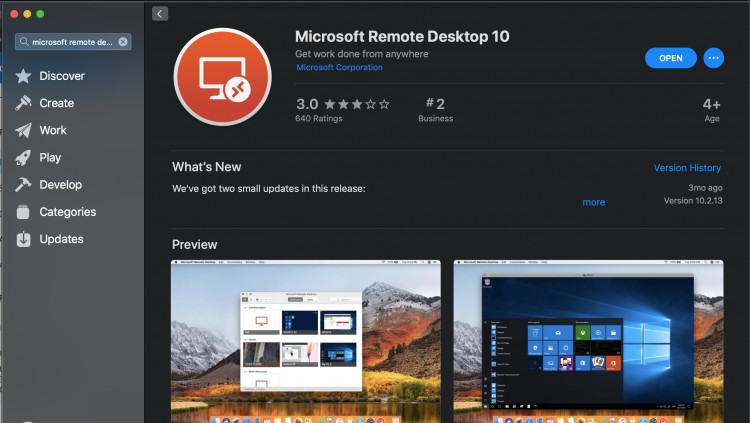In Remote Desktop Connection, type the name of the PC you want to connect to (from Step 1), and then select Connect. On your Windows, Android, or iOS device: Open the Remote Desktop app (available for free from Microsoft Store, Google Play, and the Mac App Store), and add the name of the PC that you want to connect to (from Step 1).
We're often asked how the different Remote Desktop clients compare to each other. The following table lists the features currently available in each of our clients.
Client features
- From your Windows PC, access the Microsoft Remote Desktop assistant to configure it for remote access from another device using the Remote Desktop apps for Windows, macOS, iOS or Android. Email myself a link to the Microsoft Remote Desktop Assistant.
- Click REPORTING to navigate to Remote Access Reporting in the Remote Access Management Console. Click Remote Client Status to navigate to the remote client activity and status user interface in the Remote Access Management Console. You will see the list of users who are connected to the Remote Access server and detailed statistics about them.
- Simplify infrastructure management, improve security and reduce costs by migrating your remote desktop services environment to Windows Virtual Desktop. Explore the benefits of moving your virtual desktop infrastructure (VDI) to the cloud and learn how to migrate in seven steps.
The following table compares the features of each client.
| Feature | Desktop | 10X | Mac | iOS | Android | HTML5 | Description |
|---|---|---|---|---|---|---|---|
| Remote Desktop | X | X | X | X | X | X | Desktop of a remote computer presented in a full screen or windowed mode. |
| Integrated remote apps (RAIL) | X | X | Individual remote apps integrated into the local desktop as if they are running locally. | ||||
| Immersive remote apps | X | X | X | X | X | Individual remote apps presented in a window or maximized to a full screen. | |
| Multimonitor | X | X | Lets the user run Remote Desktop or remote apps on all local monitors. | ||||
| Dynamic resolution | X | X | X | X | Resolution and orientation of local monitors is dynamically reflected in the remote session. If the client is running in windowed mode, the remote desktop is resized dynamically to the size of the client window. | ||
| Smart sizing | X | X | X | Remote Desktop in Windowed mode is dynamically scaled to the window's size. | |||
| Localization | X | X | X | X | English only. | X | User interface is available in multiple languages. |
| Multi-factor authentication | X | X | X | X | X | X | Supports multi-factor authentication for remote connections. |
| SSO with ADFS | X | X | Supports Single Sign-On (SSO) used with Active Directory Federeation Services (ADFS). | ||||
| Teams optimization for Windows Virtual Desktop | X | Media optimizations for Microsoft Teams to provide high quality calls and screen sharing experiences. Learn more at Use Microsoft Teams on Windows Virtual Desktop. |
Other resources

If you're looking for information about device redirections, check out Compare the clients: redirections.
TodayMicrosoft released a set of fixes for Remote Desktop Services that include twocritical Remote Code Execution (RCE) vulnerabilities, CVE-2019-1181 and CVE-2019-1182. Likethe previously-fixed ‘BlueKeep’ vulnerability (CVE-2019-0708), these two vulnerabilities are also ‘wormable’, meaning that anyfuture malware that exploits these could propagate from vulnerable computer tovulnerable computer without user interaction.
The affected versions of Windows are Windows 7 SP1, Windows Server 2008 R2 SP1, Windows Server 2012, Windows 8.1, Windows Server 2012 R2, and all supported versions of Windows 10, including server versions.
Windows XP, Windows Server 2003, and Windows Server 2008 are not affected, nor isthe Remote Desktop Protocol (RDP) itself affected.
These vulnerabilitieswere discovered by Microsoft during hardening of Remote Desktop Services aspart of our continual focus on strengthening the security of our products. Atthis time, we have no evidence that these vulnerabilities were known to anythird party.
It is important that affected systems are patched as quickly as possible because of the elevated risks associated with wormable vulnerabilities like these, and downloads for these can be found in the Microsoft Security Update Guide. Customers who have automatic updates enabled are automatically protected by these fixes. By default, Windows 10 Home and Windows 10 Pro users will be updated automatically.
Thereis partial mitigation on affected systems that have Network LevelAuthentication (NLA) enabled. The affected systems are mitigated against‘wormable’ malware or advanced malware threats that could exploit thevulnerability, as NLA requires authentication before the vulnerability can betriggered. However, affected systems are still vulnerable to Remote CodeExecution (RCE) exploitation if the attacker has valid credentials that can beused to successfully authenticate.
Microsoft Remote Desktop Dmg Ever Dirty Games
Resources
Links to downloads
Microsoft Remote Desktop Dmg Ever Dirty Mac
SimonPope, Director of Incident Response, Microsoft Security Response Center (MSRC)
